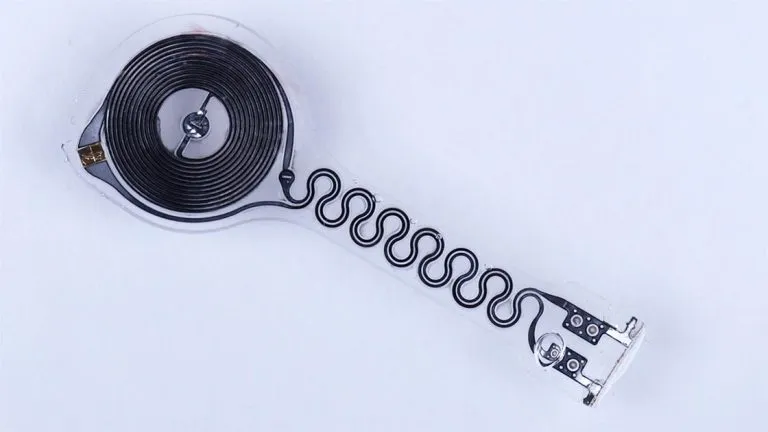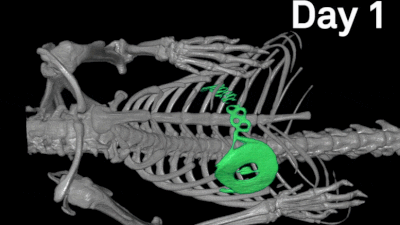Last summer, scientists at Northwestern University launched the first transient pacemaker in history -- a fully implantable wireless device that can be harmlessly dissolved in the body when it is no longer needed. Now, they have launched a new intelligent version, which is integrated into a coordination network composed of wireless, soft, flexible and wearable sensors and control units placed around the upper body**

The study was published in [Science] on May 27( https://www.science.org/doi/10.1126/science.abm1703 ) 》In magazines. This work was led by John A. Rogers, Igor r r. Efimov and Rishi Arora of Northwestern University.
These sensors communicate with each other and continuously monitor various physiological functions of the body, including body temperature, oxygen level, respiration, physical activity, muscle tension and electrical activity of the heart.
The system then uses algorithms to automatically analyze these integrated activities to autonomously detect abnormal rhythms and decide when and at what rate to pace the heart. All this information flows to smartphones or tablets, so doctors can monitor their patients remotely.

The new transient pacemaker and sensor / control network can be used for patients who need temporary pacing or are waiting for a permanent pacemaker after cardiac surgery. The pacemaker wirelessly gets energy from a node in the network - a small wireless device that can be attached to the patient's chest. This technology eliminates the need for external hardware, including wires.
To enable the system to "communicate" with patients, researchers added a small, wearable tactile feedback device that can be worn anywhere in the body. When the sensor detects a problem (such as low battery power, incorrect device position or pacemaker failure), the haptic device vibrates in a specific mode to alert the wearer and inform them of the problem.
"This marks the first time we have paired a soft, wearable electronic product with a transient electronic platform," Rogers said. "This approach can change the way patients receive care and provide multi-mode, closed-loop control of basic physiological processes - through wireless networks of sensors and stimulators, its operation is inspired by the complex, biofeedback loops that control the behavior in the organism."

"For temporary cardiac pacing, the system enables patients to get rid of the monitoring and stimulation devices that restrict them to the hospital environment. On the contrary, patients can recover comfortably in their own home while maintaining the sense of comfort brought by remote monitoring by doctors. This will also reduce the cost of medical care and make room for other patients."
Efimov said: "In the current situation, a temporary pacemaker needs a wire connected to an external generator that stimulates the heart. When the heart regains proper self stimulation ability, it must be unplugged. As you might imagine, unplugging the wire connected to the heart is a quite dramatic process. We decided to deal with this problem from a different perspective. We created a pacemaker that can be simply dissolved , does not need to be removed. This avoids the dangerous step of unplugging the wires. "
"Current pacemakers are quite intelligent and respond well to the changing needs of patients," Arora said. "However, wearable modules can accomplish everything that traditional pacemakers do, or even more. Patients basically wear a small patch on their chest and get real-time feedback to control the pacemaker. Not only is the pacemaker bioabsorbable, it is also controlled by a soft wearable patch, so that the pacemaker can respond to normal life activities without implanting sensors."
Rogers is Professor Louis Simpson and Kimberly quayley of materials science and engineering, biomedical engineering and neurosurgery at the McCormick School of engineering and the Feinberg School of medicine at Northwestern University, and director of the quayley Simpson Institute of Bioelectronics (qsib). Efimov is a professor of Biomedical Engineering at McCormick and a professor of Medicine (Cardiology) at Feinberg. Arora is a Feinberg professor of medicine and co director of the arrhythmia research center.
Connect to the body area network
As a pioneer in Bioelectronics, Rogers and his lab researchers have been developing soft and flexible wireless wearable devices and bio portable electronic technologies for nearly two decades. In the new study, Rogers and his collaborators combined and coordinated their bioabsorbable lead-free pacemakers with four different skin interface devices to work together. The equipment installed on the skin is soft and elastic. It can be gently stripped after use without surgical removal. Pacemakers will naturally dissolve in the body after being used for a period of time.
This "body area network" includes:
-A battery free transient bioabsorbable pacemaker for temporary cardiac pacing;
-A heart module located in the chest provides power for the implanted pacemaker, controls stimulation parameters, and senses the electrical activity and sound of the heart;
-A hemodynamic module located in the forehead is used to sense pulse oxygen saturation, tissue oxygen saturation and vascular tension;
-A breathing module located at the bottom of the throat to monitor cough and respiratory activity;
-A multi tactile feedback module that vibrates and pulses in various modes to "communicate" with the patient.
"We want to prove that it is possible to deploy many different types of devices, each of which performs basic functions throughout the body in a wireless coordinated manner," Rogers said. "Some are sensing. Some provide power. Some are stimulating. Some provide control signals. But they all work together, exchanging information, making decisions based on algorithms, and responding to changing conditions. The vision of multiple bioelectronic devices talking to each other and performing different functions in different relevant anatomical locations is a frontier field that we will continue to pursue in the future."
Since the first introduction of the transient pacemaker at Northwestern University a year ago, researchers have made a number of improvements to advance the technology. The former equipment is flexible, while the new equipment is flexible and elastic, so that it can better adapt to the changes of heart beat. Another new benefit: as the transient pacemaker slowly and innocuously dissolves, it now releases an anti-inflammatory drug to prevent foreign body reactions.
Perhaps the most influential development is that the device can provide pacing on demand according to the needs of patients. Synchronized with the pacemaker, the heart module installed in the chest records ECG in real time to monitor cardiac activity. In this study, the researchers compared this wireless technology with the gold standard ECG and found that it was as accurate and accurate as the clinical level system.
"The heart module actually tells the pacemaker to stimulate the heart. If normal activity returns, it stops pacing. This is important because if you stimulate the heart when it is not necessary, you may induce arrhythmias," Efimov explained
"The pacing system is completely autonomous," said Yeon sik Choi, a postdoctoral researcher at Rogers laboratory and one of the first authors of the paper. "It can automatically detect problems and apply treatment. It is easy and self-contained, with minimal external demand."
Health care that is gentle enough for newborns
Rogers, Efimov, Arora and their team believe that their system is most beneficial to the most vulnerable patients. Every year, about 40000 babies are born with a hole in the wall separating the upper chamber of the heart. About 10000 of these cases are life-threatening and require immediate surgery. After surgery, 100% of infants receive a temporary pacemaker.
"The good news is that this is a temporary situation," Efimov said. "About five to seven days later, the heart regains its ability to stimulate itself and no longer needs a pacemaker. Over the years, the procedure for removing pacemakers has been greatly improved, so the incidence of complications is very low. But we can free these babies from the wires connected to the external generator, so that they do not need a second operation."